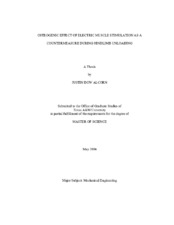| dc.description.abstract | Rats that undergo hindlimb unloading (HU) as a simulation for space flight
experience bone changes similar to astronauts in microgravity. The purpose of this
research was to assess whether an exercise countermeasure would be effective in
preventing or mitigating bone degradation during HU. Controlled electrical muscle
stimulation was applied to the lower left hindlimb to simulate resistive exercise.
Adult 6-mo. old male rats were assigned to 3 groups of 12 each: hindlimb
unloaded (HU), aging cage control (CC), and baseline (BL). The CC group was pair-fed
to match the nutritional intake of HU animals during the 28 days of the study. The left
leg was exercised 3 days a week for the duration of the study, with the unexercised right
leg serving as a contra-lateral control. Mechanical tests were conducted to assess the
strength of cancellous bone in the proximal tibia metaphysis. Although isolated
specimens of cancellous bone are not feasible, reduced platen compression (RPC) was
employed to directly load only the cancellous core region of each specimen.
There was no significant difference in ultimate stress or elastic modulus between
BL, CC, and HU-Ex (exercised). However, HU-Ex results were dramatically and
significantly higher than HU-No Ex (contra-lateral unexercised control) for both
ultimate stress (68%) and elastic modulus (81%). It is also notable that ultimate stress
was 32% higher (but not statistically significant) for HU-Ex compared to CC. The total
bone mineral density in the tibial metaphysis was significantly larger, 11%, in the HUEx
compared to the HU-No Ex group's values. The results clearly demonstrate the
efficacy of the exercise protocol in preventing the substantial mechanical deterioration
induced by HU. | en |


